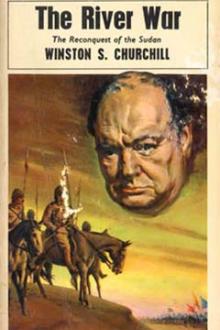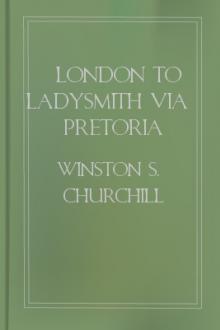The River War - Winston Churchill (books under 200 pages .txt) 📗

- Author: Winston Churchill
- Performer: -
Book online «The River War - Winston Churchill (books under 200 pages .txt) 📗». Author Winston Churchill
The Dervish centre had come within range. But it was not the British and Egyptian army that began the battle. If there was one arm in which the Arabs were beyond all comparison inferior to their adversaries, it was in guns. Yet it was with this arm that they opened their attack.
In the middle of the Dervish line now marching in frontal assault were two puffs of smoke. About fifty yards short of the thorn fence two red clouds of sand and dust sprang up, where the projectiles had struck.
It looked like a challenge. It was immediately answered. Great clouds of smoke appeared all along the front of the British and Soudanese brigades.
One after another four batteries opened on the enemy at a range of about 3,000 yards. The sound of the cannonade rolled up to us on the ridge, and was re-echoed by the hills. Above the heads of the moving masses shells began to burst, dotting the air with smoke-balls and the ground with bodies. But a nearer tragedy impended. The ‘White Flags’ were nearly over the crest. In another minute they would become visible to the batteries. Did they realise what would come to meet them? They were in a dense mass, 2,800 yards from the 32nd Field Battery and the gunboats.
The ranges were known. It was a matter of machinery. The more distant slaughter passed unnoticed, as the mind was fascinated by the approaching horror. In a few seconds swift destruction would rush on these brave men.
They topped the crest and drew out into full view of the whole army.
Their white banners made them conspicuous above all. As they saw the camp of their enemies, they discharged their rifles with a great roar of musketry and quickened their pace. For a moment the white flags advanced in regular order, and the whole division crossed the crest and were exposed.
Forthwith the gunboats, the 32nd British Field Battery, and other guns from the zeriba opened on them. About twenty shells struck them in the first minute. Some burst high in the air, others exactly in their faces. Others, again, plunged into the sand and, exploding, dashed clouds of red dust, splinters, and bullets amid their ranks. The white banners toppled over in all directions. Yet they rose again immediately, as other men pressed forward to die for the Mahdi’s sacred cause and in the defence of the successor of the True Prophet. It was a terrible sight, for as yet they had not hurt us at all, and it seemed an unfair advantage to strike thus cruelly when they could not reply. Under the influence of the shells the mass of the ‘White Flags’ dissolved into thin lines of spearmen and skirmishers, and came on in altered formation and diminished numbers, but with unabated enthusiasm. And now, the whole attack being thoroughly exposed, it became the duty of the cavalry to clear the front as quickly as possible, and leave the further conduct of the debate to the infantry and the Maxim guns. All the patrols trotted or cantered back to their squadrons, and the regiment retired swiftly into the zeriba, while the shells from the gunboats screamed overhead and the whole length of the position began to burst into flame and smoke. Nor was it long before the tremendous banging of the artillery was swollen by the roar of musketry.
Taking advantage of the shelter of the river-bank, the cavalry dismounted; we watered our horses, waited, and wondered what was happening. And every moment the tumult grew louder and more intense, until even the flickering stutter of the Maxims could scarcely be heard above the continuous din.
Eighty yards away, and perhaps twenty feet above us, the 32nd Field Battery was in action. The nimble figures of the gunners darted about as they busied themselves in their complicated process of destruction. The officers, some standing on biscuit-boxes, peered through their glasses and studied the effect. Of this I had one glimpse. Eight hundred yards away a ragged line of men were coming on desperately, struggling forward in the face of the pitiless fire—white banners tossing and collapsing; white figures subsiding in dozens to the ground; little white puffs from their rifles, larger white puffs spreading in a row all along their front from the bursting shrapnel.
The infantry fired steadily and stolidly, without hurry or excitement, for the enemy were far away and the officers careful. Besides, the soldiers were interested in the work and took great pains. But presently the mere physical act became tedious. The tiny figures seen over the slide of the backsight seemed a little larger, but also fewer at each successive volley.
The rifles grew hot—so hot that they had to be changed for those of the reserve companies. The Maxim guns exhausted all the water in their jackets, and several had to be refreshed from the water-bottles of the Cameron Highlanders before they could go on with their deadly work. The empty cartridge-cases, tinkling to the ground, formed a small but growing heap beside each man. And all the time out on the plain on the other side bullets were shearing through flesh, smashing and splintering bone; blood spouted from terrible wounds; valiant men were struggling on through a hell of whistling metal, exploding shells, and spurting dust—suffering, despairing, dying. Such was the first phase of the battle of Omdurman.
The Khalifa’s plan of attack appears to have been complex and ingenious.
It was, however, based on an extraordinary miscalculation of the power of modern weapons; with the exception of this cardinal error, it is not necessary to criticise it. He first ordered about 15,000 men, drawn chiefly from the army of Osman Sheikh-ed-Din and placed under the command of Osman Azrak, to deliver a frontal attack. He himself waited with an equal force near Surgham Hill to watch the result. If it succeeded, he would move forward with his bodyguard, the flower of the Arab army, and complete the victory. If it failed, there was yet another chance. The Dervishes who were first launched against the zeriba, although very brave men, were not by any means his best or most reliable troops. Their destruction might be a heavy loss, but it would not end the struggle. While the attack was proceeding, the valiant left, consisting of the rest of the army of Osman Sheikh-ed-Din, might move unnoticed to the northern flank and curve round on to the front of the zeriba held by the Egyptian brigade. Ali-Wad-Helu was meanwhile to march to the Kerreri Hills, and remain out of range and, if possible, out of sight among them. Should the frontal and flank attacks be unhappily repulsed, the ‘enemies of God,’ exulting in their easy victory over the faithful, would leave their strong place and march to the capture and sack of the city. Then, while they were yet dispersed on the plain, with no zeriba to protect them, the chosen warriors of the True Religion would abandon all concealment, and hasten in their thousands to the utter destruction of the accursed—the Khalifa with 15,000 falling upon them from behind Surgham; Ali-Wad-Helu and all that remained of Osman’s army assailing them from Kerreri. Attacked at once from the north and south, and encompassed on every side, the infidels would abandon hope and order, and Kitchener might share the fate of Hicks and Gordon. Two circumstances, which will appear as the account proceeds, prevented the accomplishment of this plan. The second attack was not executed simultaneously by the two divisions of the Dervish army; and even had it been, the power of the musketry would have triumphed, and though the Expeditionary Force might have sustained heavier losses the main result could not have been affected.
The last hopes of barbarism had passed with the shades of night.
Colonel Broadwood, with nine squadrons of cavalry, the Camel Corps, and the Horse Artillery, had been ordered to check the Dervish left, and prevent it enveloping the downstream flank of the zeriba, as this was held by the Egyptian brigade, which it was not thought desirable to expose to the full weight of an attack. With this object, as the Dervishes approached, he had occupied the Kerreri ridge with the Horse battery and the Camel Corps, holding his cavalry in reserve in rear of the centre.
The Kerreri ridge, to which reference has so frequently been made, consists of two main features, which rise to the height of about 300 feet above the plain, are each above a mile long, and run nearly east and west, with a dip or trough about 1,000 yards wide between them. The eastern ends of these main ridges are perhaps 1,000 yards from the river, and in this intervening space there are several rocky under-features and knolls.
The Kerreri Hills, the spaces between them, and the smaller features are covered with rough boulders and angular stones of volcanic origin, which render the movements of horses and camels difficult and painful.
The cavalry horses and camels were in the dip between the two ridges; and the dismounted men of the Camel Corps were deployed along the crest of the most southerly of the ridges, with their right at the desert end.
Next in order to the Camel Corps, the centre of the ridge was occupied by the dismounted cavalry. The Horse Artillery were on the left.
The remainder of the cavalry waited in the hollow behind the guns.
The tempestuous advance of Osman soon brought him into contact with the mounted force. His real intentions are still a matter of conjecture.
Whether he had been ordered to attack the Egyptian brigade, or to drive back the cavalry, or to disappear behind the Kerreri Hills in conformity with Ali-Wad-Helu, is impossible to pronounce. His action was, however, clear. He could not safely assail the Egyptians with a powerful cavalry force threatening his left rear. He therefore continued his move across the front of the zeriba. Keeping out of the range of infantry fire, bringing up his right, and marching along due north, he fell upon Broadwood.
This officer, who had expected to have to deal with small bodies on the Dervish flank, found himself suddenly exposed to the attack of nearly 15,000 men, many of whom were riflemen. The Sirdar, seeing the situation from the zeriba, sent him an order to withdraw within the lines of infantry. Colonel Broadwood, however, preferred to retire through the Kerreri Hills to the northward, drawing Osman after him.
He replied to that effect.
The first position had soon to be abandoned. The Dervishes, advancing in a north-easterly direction, attacked the Kerreri Hills obliquely. They immediately enveloped the right flank of the mounted troops holding them. It will be seen from the map that as soon as the Dervish riflemen gained a point west and in prolongation of the trough between the two ridges, they not only turned the right flank, but also threatened the retreat of the defenders of the southerly ridge; for they were able to sweep the trough from end to end with their





Comments (0)